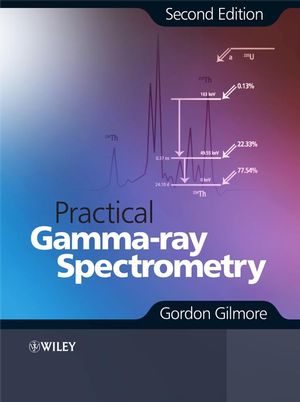Practical Gamma-ray Spectroscopy, 2nd EditionISBN: 978-0-470-86196-7
Hardcover
408 pages
May 2008
 This is a Print-on-Demand title. It will be printed specifically to fill your order. Please allow an additional 15-20 days delivery time. The book is not returnable.
|
||||||
Preface to the First Edition xvii
Internet Resources within the Book xix
1 Radioactive Decay and the Origin of Gamma and X-Radiation
1
1.1 Introduction 1
1.2 Beta Decay 2
1.3 Alpha Decay 7
1.4 Spontaneous Fission (SF) 8
1.5 Minor Decay Modes 8
1.6 Gamma Emission 8
1.7 Other Sources of Photons 12
1.8 The Mathematics of Decay and Growth of Radioactivity 15
1.9 The Chart of the Nuclides 19
2 Interactions of Gamma Radiation with Matter 25
2.1 Introduction 25
2.2 Mechanisms of Interaction 25
2.3 Total Attenuation Coefficients 29
2.4 Interactions within the Detector 30
2.5 Interactions within the Shielding 33
2.6 Bremsstrahlung 35
2.7 Attenuation of Gamma Radiation 36
2.8 The Design of Detector Shielding 36
3 Semiconductor Detectors for Gamma-Ray Spectrometry
39
3.1 Introduction 39
3.2 Semiconductors and Gamma-Ray Detection 40
3.3 The Nature of Semiconductors 43
3.4 The Manufacture of Germanium Detectors 45
3.5 Detector Capacitance 49
3.6 Charge Collection in Detectors 50
3.7 Packaging of Detectors 55
4 Electronics for Gamma-Ray Spectrometry 61
4.1 The General Electronic System 61
4.2 Detector Bias Supplies 66
4.3 Preamplifiers 66
4.4 Amplifiers and Pulse Processors 70
4.5 Resolution Enhancement 80
4.6 Multichannel Analysers and their Analogue-to-Digital Converters
81
4.7 Live Time Correction and Loss-Free Counting 92
4.8 Spectrum Stabilization 94
4.9 Coincidence and Anticoincidence Gating 96
4.10 Multiplexing and Multiscaling 96
4.11 Digital Pulse Processing Systems 97
5 Statistics of Counting 101
5.1 Introduction 101
5.2 Counting Distributions 102
5.3 Sampling Statistics 104
5.4 Peak Area Measurement 108
5.5 Optimizing Counting Conditions 111
5.6 Counting Decision Limits 114
5.7 Special Counting Situations 121
5.8 Uncertainty Budgets 123
6 Resolution: Origins and Control 131
6.1 Introduction 131
6.2 Charge Production – wP 133
6.3 Charge Collection – wC 134
6.4 Electronic Noise – wE 136
6.5 Resolving the Peak Width Calibration 138
7 Spectrometer Calibration 143
7.1 Introduction 143
7.2 Reference Data for Calibration 143
7.3 Sources for Calibration 144
7.4 Energy Calibration 144
7.5 Peak Width Calibration 147
7.6 Efficiency Calibration 150
7.7 Mathematical Efficiency Calibration 160
8 True Coincidence Summing 165
8.1 Introduction 165
8.2 The Origin of Summing 166
8.3 Summing and Solid Angle 166
8.4 Spectral Evidence of Summing 167
8.5 Validity of Close Geometry Calibrations 168
8.6 Summary 171
8.7 Summing in Environmental Measurements 171
8.8 Achieving Valid Close Geometry Efficiency Calibrations
172
8.9 TCS, Geometry and Composition 174
8.10 Achieving 'Summing-free' measurements 175
8.11 Mathematical Summing Corrections 176
8.12 Software for Correction of TCS 178
9 Computer Analysis of Gamma-Ray Spectra 183
9.1 Introduction 183
9.2 Methods of Locating Peaks in the Spectrum 185
9.3 Library Directed Peak Searches 187
9.4 Energy Calibration 188
9.5 Estimation of the Peak Centroid 189
9.6 Peak Width Calibration 189
9.7 Determination of the Peak Limits 191
9.8 Measurements of Peak Area 192
9.9 Full Energy Peak Efficiency Calibration 193
9.10 Multiplet Peak Resolution by Deconvolution 195
9.11 Peak Stripping as a Means of Avoiding Deconvolution 196
9.12 The Analysis of the Sample Spectrum 197
9.13 Nuclide Identification 200
9.14 The Final Report 200
9.15 Setting Up Nuclide and Gamma-Ray Libraries 201
9.16 Buying Spectrum Analysis Software 202
9.17 The Spectrum Analysis Programs Referred to in the Text 202
10 Scintillation Spectrometry 205
10.1 Introduction 205
10.2 The Scintillation Process 205
10.3 Scintillation Activators 206
10.4 Life time of Excited States 206
10.5 Temperature Variation of the Scintillator Response 207
10.6 Scintillator Detector Materials 207
10.7 Photomultiplier Tubes 211
10.8 The Photocathode 211
10.9 The Dynode Electron Multiplier Chain 212
10.10 Photodiode Scintillation Detectors 212
10.11 Construction of the Complete Detector 213
10.12 The Resolution of Scintillation Systems 214
10.13 Electronics for Scintillation Systems 216
10.14 Comparison of Sodium Iodide and Germanium Detectors 218
11 Choosing and Setting up a Detector, and Checking its
Specifications 221
11.1 Introduction 221
11.2 Setting up a Germanium Detector System 222
11.3 Optimizing the Electronic System 228
11.4 Checking the Manufacturer's Specification 232
12 Troubleshooting 239
12.1 Fault-Finding 239
12.2 Preamplifier Test Point and Leakage Current 243
12.3 Thermal Cycling of the Detector 244
12.4 Ground Loops, Pick-up and Microphonics 246
13 Low Count Rate Systems 251
13.1 Introduction 251
13.2 Counting with High Efficiency 253
13.3 The Effect of Detector Shape 257
13.4 Low Background Systems 262
13.5 Active Background Reduction 270
13.6 Ultra-Low-Level Systems 273
14 High Count Rate Systems 279
14.1 Introduction 279
14.2 Detector Throughput 280
14.3 Preamplifiers for High Count Rate 281
14.4 Amplifiers 283
14.5 Digital Pulse Processing 286
14.6 The ADC and MCA 288
14.7 Dead Times and Throughput 288
14.8 System Checks 292
15 Ensuring Quality in Gamma-Ray Spectrometry 295
15.1 Introduction 295
15.2 Nuclear Data 296
15.3 Radionuclide Standards 296
15.4 Maintaining Confidence in the Equipment 297
15.5 Gaining Confidence in the Spectrum Analysis 301
15.6 Maintaining Records 311
15.7 Accreditation 312
16 Gamma Spectrometry of Naturally Occurring Radioactive
Materials (NORM) 315
16.1 Introduction 315
16.2 The NORM Decay Series 315
16.3 Gamma Spectrometry of the NORM Nuclides 318
16.4 Nuclear Data of the NORM Nuclides 324
16.5 Measurement of Chemically Modified NORM 324
17 Applications 329
17.1 Gamma Spectrometry and the CTBT 329
17.2 Gamma Spectrometry of Nuclear Industry Wastes 333
17.3 Safeguards 335
17.4 PINS – Portable Isotopic Neutron Spectrometry 340
Appendix A: Sources of Information 343
A.1 Introduction 343
A.2 Nuclear Data 343
A.3 Internet Sources of Other Nuclear Data 347
A.4 Chemical Information 347
A.5 Miscellaneous Information 348
A.6 Other Publications in print 348
Appendix B: Gamma- and X-Ray Standards for Detector Calibration 351
Appendix C: X-Rays Routinely Found in Gamma Spectra 359
Appendix D: Gamma-Ray Energies in the Detector Background and the Environment 361
Appendix E: Chemical Names, Symbols and Relative Atomic Masses of the Elements 365
Glossary 369
Index 381



